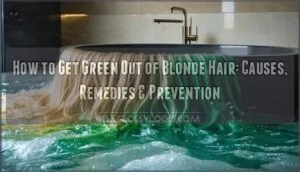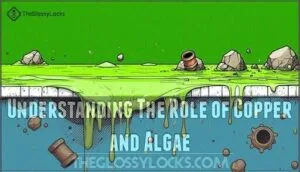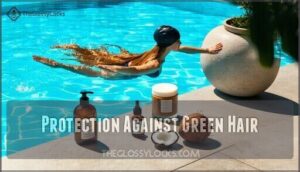This site is supported by our readers. We may earn a commission, at no cost to you, if you purchase through links.
 You step out of the pool, towel off, and catch your reflection—your carefully maintained blonde has turned an unmistakable shade of swamp green. It’s not chlorine that’s betrayed you. The real culprit is copper lurking in the water, oxidizing on contact with your hair and binding to the keratin like rust on metal.
You step out of the pool, towel off, and catch your reflection—your carefully maintained blonde has turned an unmistakable shade of swamp green. It’s not chlorine that’s betrayed you. The real culprit is copper lurking in the water, oxidizing on contact with your hair and binding to the keratin like rust on metal.
Blonde hair shows this chemical reaction more dramatically because its light color and porous texture act like a blank canvas for mineral deposits.
The good news? You don’t need to panic or reach for bleach. Simple household items and targeted products can reverse the damage, and a few smart habits will keep your hair from turning green in the first place.
Table Of Contents
- Key Takeaways
- What Causes Green Tints in Blonde Hair?
- Understanding The Role of Copper and Algae
- Testing Your Pool Water for Copper
- Preventive Measures for Green Hair
- Protection Against Green Hair
- Natural Remedies for Removing Green Tints
- Tips and Tactics to Avoid Green Hair
- Consult a Professional for Hair Care Products
- Frequently Asked Questions (FAQs)
- Why does bleached blonde hair turn green?
- How do you get green hair out of hair?
- How to remove green tones in blonde hair?
- How to remove green tints from blonde hair?
- Can you get green out of blonde hair without bleach?
- How to remove green color from bleached hair?
- How often should I test my pool water for copper?
- How long does green hair discoloration typically last?
- Does hair porosity affect green hair susceptibility?
- Are there specific pool chemicals worse for hair?
- Conclusion
Key Takeaways
- Green hair happens when copper ions from pool water (not chlorine) oxidize and bind to blonde hair’s porous structure, with copper levels above 0.5 ppm causing visible staining.
- Prevention works better than treatment—wet your hair with fresh water first, apply leave-in conditioner or oil as a barrier, and wear a fitted swim cap to block up to 90% of metal exposure.
- Home remedies like clarifying shampoo, baking soda paste, vinegar rinses, or ketchup (which neutralizes green with red pigments) effectively remove copper buildup without harsh chemicals when used consistently.
- Test your pool water weekly for copper levels and rinse hair immediately after swimming, since damaged or chemically treated hair absorbs metals faster than healthy hair.
What Causes Green Tints in Blonde Hair?
Ever wonder why your beautiful blonde locks suddenly look more like a science experiment gone wrong after a dip in the pool? The culprit isn’t chlorine—it’s copper. Over 90% of green hair cases happen when copper ions from pool water latch onto your hair shaft. Chlorine oxidizes these copper deposits, creating that unwanted greenish tint.
Copper, not chlorine, turns blonde hair green when pool water deposits oxidize on your hair shaft
Blonde hair shows this discoloration more dramatically because of its light base and porous texture. Hair products containing metals, hard water minerals, and even incorrectly applied toners can trigger similar reactions. Your hair virtually becomes a magnet for mineral oxidation, turning chemical exposure into visible color changes.
Understanding The Role of Copper and Algae
You know copper causes the problem, but where does it come from? Most pools use copper-based algaecides, like copper sulfate, to keep algae under control. These products add copper ions directly to the water, usually around 0.5 ppm to stop algae growth. When pool owners overdose or treat persistent algae blooms repeatedly, copper levels climb fast.
Here’s what’s happening with copper and algae:
- Algaecides introduce copper: Copper sulfate is the go-to algae killer, but it leaves copper behind in the water
- Algae itself doesn’t cause green hair: The copper added to control algae is what stains your blonde hair
- Damaged hair absorbs more copper: Bleached or chemically treated hair has raised cuticles that grab copper ions
- Acidic water increases copper: When pool pH drops below 7.2, copper pipes and equipment leak more copper into the water
- Copper binds to keratin: Copper attaches to the sulfur groups in your hair’s protein structure, creating that persistent green color
Water chemistry matters too. Low pH water pulls copper from pipes and increases how much your hair absorbs. To combat this issue, a metal detox treatment can neutralize the metals.
Testing Your Pool Water for Copper
Now that you understand how copper gets into your pool, the next step is checking if your water actually has too much of it. DIY test kits from pool supply stores make testing simple. Look for kits that measure copper specifically, not just pH and chlorine. Testing strips give quick readings, while liquid reagent kits offer more accuracy for water quality analysis.
Here’s what your copper levels mean:
| Copper Level (ppm) | Water Quality Status |
|---|---|
| 0–0.2 | Safe, no discoloration risk |
| 0.3–0.5 | Borderline, monitor closely |
| 0.6–1.0 | High, hair staining likely |
| 1.1–2.0 | Very high, immediate action needed |
| 2.0+ | Extreme, professional pool maintenance required |
Test your water minerals weekly during swim season. Professional testing at pool stores confirms DIY results and catches other water chemistry issues. Interpreting results helps you catch problems before they stain your blonde hair green.
Preventive Measures for Green Hair
You can stop green hair before it starts by taking a few simple steps before you swim. The key is creating a barrier between your hair and the pool water.
Here’s what works best to keep your blonde looking bright.
Pre-treating Your Hair
Think of pre-treating your hair like putting on sunscreen before heading to the beach—it’s your first line of defense against the harsh effects of pool water. A solid pre-swim routine creates protective barriers that prevent copper absorption and chlorine damage.
Here’s your hair protection strategy:
- Apply leave-in treatments with Argan oil benefits to seal the cuticle
- Use silicone conditioners as a seal coat against metals
- Coat strands with protective oils before entering the pool
- Consider a preswim treatment spray for extra defense
These preventive measures reduce metal uptake considerably, keeping your blonde looking fresh.
Wetting Your Hair Before Swimming
Before you even step foot on the pool deck, hit the shower and thoroughly drench your hair with clean, fresh water. This simple step reduces copper uptake by saturating your strands first, preventing green hair.
Hair porosity matters here—the more water your hair absorbs from tap water, the less room there’s for chlorine and metals from swimming pool water to penetrate.
This straightforward hair protection strategy takes seconds but makes a real difference in preventing discoloration.
Using Conditioner
After wetting your hair, coat it generously with a leave-in conditioner or regular conditioner to create a protective barrier against copper and chlorine. Look for products with silicone-based formulas or Argan oil, which seal the hair cuticle and reduce metal absorption by up to 30%.
Apply conditioner from roots to ends before swimming, focusing on the most porous sections. This layer blocks pool chemicals from penetrating your blonde hair strands, greatly lowering your risk of green discoloration.
Rinse lightly if needed, but leave enough product to maintain protection throughout your swim.
Wearing a Swim Cap
A swim cap acts as your first line of defense, cutting metal exposure by up to 90% compared to swimming with uncovered hair. Choose silicone or latex cap material for the best chlorine damage prevention and proper fit. Secure it completely over your hairline to block pool chemicals effectively.
- Cap material: Silicone offers better durability than latex
- Proper fit: Eliminate gaps where chlorine can seep through
- Cap maintenance: Rinse after each use to prevent hair damage
- Alternative options: Combine with conditioner for double protection
This simple step keeps your blonde hair safe from unwanted green tints.
Protection Against Green Hair
Your hair needs a shield, not a chance—protective products applied before you jump in can stop copper and chlorine from latching onto your strands in the first place. Leave-in conditioners containing Argan oil work well as pre-swim products because they coat each strand and block mineral buildup. You can also apply coconut oil or a silicone-based serum before putting on your swim cap.
Preventing green hair in blonde hair means thinking ahead. Wear a fitted swim cap to cut down exposure by up to 90%. After swimming, post-swim care matters just as much. Rinse your hair immediately with fresh water to wash away pool chemicals before they settle in.
If you’re dealing with hard water at home, consider installing shower filters or water softeners. These remove copper and other metals that cause chlorine and hair discoloration. Protecting blonde hair from pool chemicals isn’t complicated—it just takes consistency with these preventive measures for hair discoloration.
Natural Remedies for Removing Green Tints
If you’ve spotted green tones creeping into your blonde hair, you’ll be glad to know there are simple home remedies that can help.
These methods use common household items to neutralize unwanted color without harsh chemicals.
Let’s look at three practical options you can try right away.
Using Baking Soda and Vinegar
Baking soda and vinegar work like a one-two punch for removing green tints from blonde hair caused by copper buildup. Here’s how to use these natural remedies:
- Mix 1/2 cup baking soda with water to form a paste, apply to green areas, and leave for 5–10 minutes before rinsing.
- Dilute white vinegar with equal parts water, soak hair for 10–15 minutes to break down mineral deposits, then rinse thoroughly.
- Combine lemon juice with baking soda for stubborn cases, leaving the paste on for 15–20 minutes.
Use these treatments once or twice weekly. The vinegar scent disappears after rinsing. A common cause is chlorine from pools. Follow with deep conditioner to prevent dryness.
Using Ketchup
Ketchup might sound odd, but it’s one of the most effective kitchen remedies for removing green tones from blonde hair. The red pigments in tomato ketchup neutralize green discoloration, while the acidity helps restore your hair’s natural pH balance. About 63% of home remedy guides recommend this method after pool exposure.
Here’s how to use tomato-based treatments:
| Application Method | Details |
|---|---|
| What to Apply | Tomato ketchup, tomato juice, or V8 juice work equally well for hair color correction |
| Treatment Duration | Cover hair with ketchup for 30 minutes under foil or a shower cap; tomato juice requires only 5–15 minutes |
| Rinsing Process | Wash thoroughly with warm water, then shampoo twice for complete scent removal |
| When to Repeat | One application usually works, but stubborn green tones may need a second treatment |
| Best For | Blonde hair with mild to moderate green discoloration from copper buildup |
The acidity in ketchup breaks down alkaline minerals without harsh chemicals, making it gentler than commercial color strippers while still delivering visible results.
Removing Tints With Shampoo
Clarifying shampoos with chelating agents are your best first defense against green tints caused by mineral buildup. Look for products containing EDTA, which clinically removes copper-induced discoloration over six to eight weeks of consistent use. Malibu C Swimmers shampoo and UltraSwim Chlorine Removal Shampoo are professional-grade options designed specifically for this problem.
Use clarifying shampoo once or twice weekly—overuse can dry out your hair. Always follow with a moisturizing conditioner to restore softness. For green tones that persist, try a toning shampoo with warm or red pigments. Fudge Clean Blonde Violet Toning Shampoo works well, but avoid purple shampoo, which can actually worsen green discoloration.
Apply the shampoo to damp hair, massage thoroughly, and let it sit for two to three minutes before rinsing completely.
Tips and Tactics to Avoid Green Hair
Once you know how to fix green hair, the real win is making sure it never happens again. Smart preventive measures and hair protection strategies can keep your blonde looking bright.
Here are five preventative hair care habits for swimmers:
- Test pool water chemistry regularly for copper levels above 0.5 ppm
- Apply protective product application like silicone-based conditioner or Argan oil leave-ins before swimming
- Wet hair with fresh water first to reduce copper absorption by up to 40%
- Choose quality swim cap materials that shield hair from pool chemicals
- Follow post-swim haircare routines with clarifying shampoo weekly
These hair care tips for swimmers work together to block mineral buildup and prevent green tints from forming in the first place.
Consult a Professional for Hair Care Products
If home remedies don’t cut it, professional hair treatments offer stronger solutions. Salon Chelating Treatments can remove copper buildup in one visit, clearing up over 90% of green tints. Stylists perform Professional Color Correction using custom-mixed toners to neutralize green hues precisely.
Beyond fixing the problem, experts provide Individualized Product Selection based on your hair’s porosity and history, Minimizing Hair Damage compared to trial-and-error experiments at home. They diagnose the Expert Root Cause—whether it’s water minerals or prior processing—and recommend professional hair products like K-PAK Clarifying Shampoo or Swimmers Wellness Remedy for ongoing protection.
Frequently Asked Questions (FAQs)
Why does bleached blonde hair turn green?
Pool water doesn’t turn blonde hair green—that’s chlorine’s reputation, but copper buildup is the real culprit.
Oxidized copper particles bind to porous blonde hair, creating that unwanted greenish tint through mineral oxidation and blonde sensitivity to metal deposits.
How do you get green hair out of hair?
To remove green tints, try clarifying shampoos, vinegar rinses, or ketchup treatment for natural remedies.
Red toners help with hair color correction, while professional chelators offer stronger solutions for removing green tints from blonde hair.
How to remove green tones in blonde hair?
You can tackle green tones using clarifying shampoos, vinegar rinses, or DIY methods like ketchup.
Red toners help with hair color correction by neutralizing unwanted hues.
Professional treatments offer stronger solutions for stubborn cases. Avoid purple shampoo—it can worsen the issue.
How to remove green tints from blonde hair?
The catch: green tints are easier to fix than you’d think, but ignoring them makes matters worse.
Try clarifying shampoos to strip buildup, red toners to neutralize cool tones, or vinegar rinses for gentle color correction. Ketchup remedy works surprisingly well for blonde hair.
Professional treatments guarantee complete hair color correction when home methods fail.
Can you get green out of blonde hair without bleach?
Yes, you can remove green tones without bleach. Natural methods like baking soda, vinegar, or ketchup work well. Clarifying shampoos and red-toned color correction products also lift green tints gently.
Professional help offers safe alternatives if home remedies don’t work.
How to remove green color from bleached hair?
You’ve got a few paths to clear those unwanted tones. Clarifying shampoos strip buildup, while red toners neutralize green by adding opposite-spectrum warmth.
DIY methods like baking soda work for mild cases, but color removers or professional treatments tackle stubborn discoloration when home remedies fall short.
How often should I test my pool water for copper?
Testing pool water for copper levels should happen weekly if you swim often, or every two weeks for occasional swimmers. Professional testing methods offer the most accurate readings.
Regular monitoring acts as preventative measures against discoloration before aquatic activities damage your hair.
How long does green hair discoloration typically last?
Green hair discoloration can last anywhere from a few days to several weeks without treatment. Severity factors like copper concentration and hair porosity affect duration.
Treatment impact matters—proper removal methods eliminate discoloration quickly, while untreated hair may worsen. Reoccurrence likelihood increases with continued pool exposure.
Does hair porosity affect green hair susceptibility?
High porosity hair absorbs copper faster than low porosity hair, making it more prone to green discoloration.
Damaged hair also has raised cuticles that trap metals, increasing copper absorption and making treatment effectiveness harder to achieve.
Are there specific pool chemicals worse for hair?
Copper and chlorine are the main troublemakers, but pH balance matters too. When pool water is too acidic or alkaline, chemical reactions intensify, making copper stick to your hair.
Chlorine alternatives and sanitizers can also interact with metals already present in the water.
Conclusion
Picture your blonde hair under running water—watching mineral buildup dissolve and true color return. That clarity doesn’t happen by accident. Understanding how to get green out of blonde hair means knowing copper’s chemistry, acting quickly with the right remedies, and protecting your strands before they change color.
Whether you choose baking soda, ketchup, or chelating shampoo, the solution starts with addressing the root cause. Your hair doesn’t have to tell the story of every pool visit. With prevention and targeted treatment, it stays the shade you intended.
- https://theconversation.com/why-does-my-hair-turn-green-from-the-swimming-pool-211736
- https://www.pblmagazine.co.uk/news/why-blonde-hair-turns-green-by-the-pool-and-how-to-prevent-it
- https://spspoolcare.com/blog/how-to-get-rid-of-green-blonde-hair-after-swimming/
- https://www.pureshowers.co.uk/shower-filter-blog/blonde-hair-turning-green-shower-water-fix
- https://voloom.com/blogs/news/how-to-get-green-out-of-hair-without-damage












